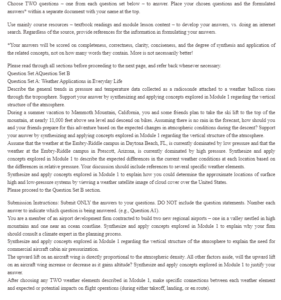Weather Applications in Everyday Life
General pressure and temperature data trends are collected as a radiosonde attached to a weather balloon rises through the troposphere.
The radiosonde in a balloon begins to work as soon as the balloon floats. The balloon’s increased movement away from the earth’s surface reduces the air that could push against the balloon’s exterior. The reduced air pressure allows the expansion of gases within the balloon, which results in increased altitude (National Geographic Society, 2022). The air pressure is low in higher altitudes. As the air within the balloon occupies more space, the balloons tend to pop once they achieve altitudes higher than 20 miles above the earth’s surface. This altitude’s temperature goes below zero, and the air thins out. Therefore, the temperature aligns with the principle that temperature drops with increased altitudes. The temperatures can go as low as -92 degrees Celsius (Collecting Meteorological Data by Radiosonde or Weather Balloon, n.d).
Weather Elements and Flight Operations
Precipitation is one of the weather aspects that affect the safety of flight operations. The main threats to safety occur during landing and takeoff. Poor visibility is the most common, as heavy rainfall renders the windshield wipers ineffective. Stagnant water on runways is dangerous, as injecting large amounts into the engine’s belly can cause a flameout. Large amounts of water accumulating on the runway can also lead to hydroplaning and increase the collision rate with birds (Cao, Wu, & Xu, 2014).
Clouds also pose a significant danger to flight operations. Specifically, the Nimbus clouds pose the greatest danger to airplanes and passengers. When flying through a cloud, visibility is poor. This can lead to collisions with other aircraft, buildings, and other landmarks. Cumulonimbus clouds tend to harbor thunderstorms, strong motions that could pull the plane vertically, extreme icing, hail, and intense turbulence. Most pilots avoid flying through such clouds due to the risk involved (Southern Wings, 2019).
References
Cao, Y., Wu, Z., & Xu, Z. (2014). Effects of rainfall on aircraft aerodynamics. Progress in Aerospace Sciences, 71. doi:10.1016/j.paerosci.2014.07.003
I am collecting Meteorological Data by Radiosonde or Weather Balloon. (n.d). Retrieved from https://www.weather.gov/rah/virtualtourballoon
National Geographic Society. (2022). Technology and the Atmosphere.
Southern Wings. (2019, May). Flying Through Clouds – Why Are They So Dangerous? Retrieved from https://www.southernwings.co.nz/flying-through-clouds-why-are-they-so-dangerous/
ORDER A PLAGIARISM-FREE PAPER HERE
We’ll write everything from scratch
Question
Choose TWO questions – one from each question set below – to answer. Place your chosen questions and the formulated answers* within a separate document with your name at the top.

Weather Applications in Everyday Life
Use mainly course resources – textbook readings and module lesson content – to develop your answers, vs. doing an internet search. Regardless of the source, provide references for the information in formulating your answers.
*Your answers will be scored on completeness, correctness, clarity, conciseness, and the degree of synthesis and application of the related concepts, not on how many words they contain. More is not necessarily better!
Please read through all sections before proceeding to the next page, and refer back whenever necessary.
Question Set AQuestion Set B
Question Set A: Weather Applications in Everyday Life
Describe the general trends in pressure and temperature data collected as a radiosonde attached to a weather balloon rises through the troposphere. Support your answer by synthesizing and applying concepts explored in Module 1 regarding the vertical structure of the atmosphere.
During a summer vacation to Mammoth Mountain, California, you and some friends plan to take the ski lift to the top of the mountain, nearly 11,000 feet above sea level, and descend on bikes. Assuming there is no rain in the forecast, how should you and your friends prepare for this adventure based on the expected changes in atmospheric conditions during the descent? Support your answer by synthesizing and applying concepts explored in Module 1 regarding the vertical structure of the atmosphere.
Assume that the weather at the Embry-Riddle campus in Daytona Beach, FL, is currently dominated by low pressure and that the weather at the Embry-Riddle campus in Prescott, Arizona, is currently dominated by high pressure. Synthesize and apply concepts explored in Module 1 to describe the expected differences in the current weather conditions at each location based on the differences in relative pressure. Your discussion should include references to several specific weather elements.
Synthesize and apply concepts explored in Module 1 to explain how you could determine the approximate locations of surface high and low-pressure systems by viewing a weather satellite image of cloud cover over the United States.
Please proceed to the Question Set B section.
Submission Instructions: Submit ONLY the answers to your questions. DO NOT include the question statements. Number each answer to indicate which question is being answered. (e.g., Question A1).
You are a member of an airport development firm contracted to build two new regional airports – one in a valley nestled in high mountains and one near an ocean coastline. Synthesize and apply concepts explored in Module 1 to explain why your firm should consult a climate expert in the planning process.
Synthesize and apply concepts explored in Module 1 regarding the vertical structure of the atmosphere to explain the need for commercial aircraft cabin air pressurization.
The upward lift on an aircraft wing is directly proportional to the atmospheric density. All other factors aside, will the upward lift on an aircraft wing increase or decrease as it gains altitude? Synthesize and apply concepts explored in Module 1 to justify your answer.
After choosing any TWO weather elements described in Module 1, make specific connections between each weather element and expected or potential impacts on flight operations (during either takeoff, landing, or en route).

